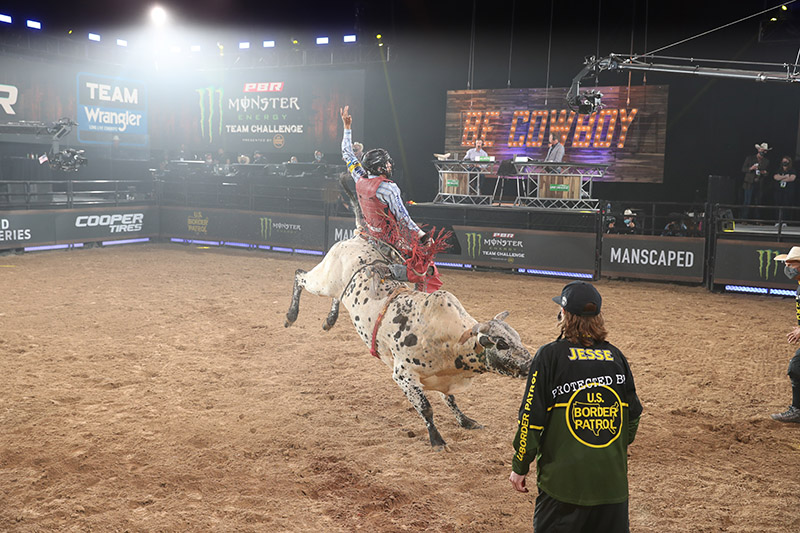A Live Sporting Event Welcomes Back Fans During Trying Times
Almost as soon as the live events industry flipped off like a light switch during the Covid-19 pandemic shutdowns in March, people have been coming up with creative ways to bring sports and music back to the fans in a safe and responsible manner — first as live televised events without an audience and, in locations allowing for people to gather with social distancing precautions, with live spectators filling at least some of the seats or, in the case of drive-in concerts, the seats of their own vehicles.
One of the first live sporting events out of the gate this year was professional bull riding. PBR (Professional Bull Riders) was able to hold closed-to-fans events for television in Georgia March 15-16 and at the Lazy E Arena in Guthrie, OK April 25-26 and May 9-10. Those events helped set the stage for the PBR Monster Energy Team Challenge held at South Point Arena in Las Vegas from June 5-28 and the first post-Covid PBR event with a partial audience at the Denny Sanford Premier Center in Sioux Falls, SD on July 10-12.
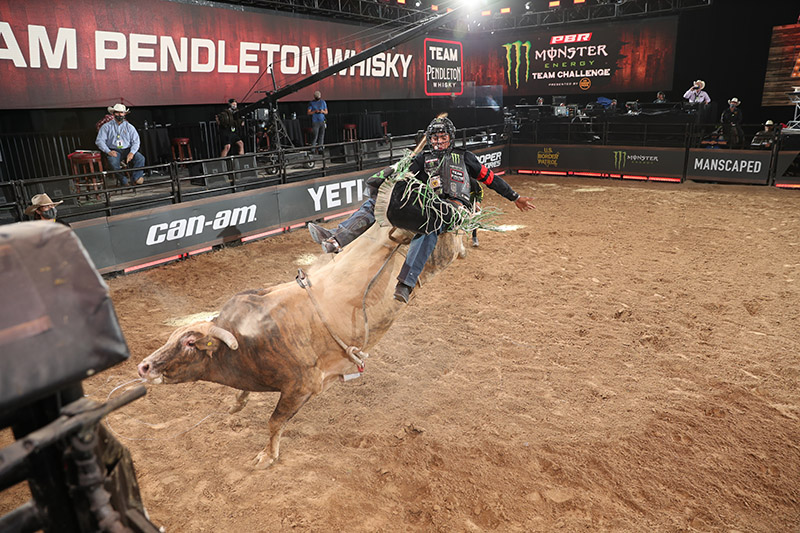
Marco Eguchi attempts to ride Kruger Bucking Bulls’s Shadow’s Recruit during the fifth perfromance of the Monster Energy Team Challenge Division B. Photo by Andy Watson
Taking the Virus by the Horns
PLSN recently sat down with Dan Hickman, VP of Production & Operations at PBR, to discuss these first shows and the challenges all live events must overcome to safely plan and prepare for a show in the middle of a pandemic. When asked about the initial steps taken, Dan replied, “The PBR executive management team took on the task of developing the initial Covid plan. We spent over a month researching Covid-19, studying the latest information available every day on how it was transmitted, and more importantly, avoided. We engaged independent medical professionals and epidemiologists to help review and fine tune our medical screening protocols to ensure that they were as safe and effective as they could possibly be. We shared the plan with regional and state health departments to get their sign-off. We also studied and contributed to plans that were being developed simultaneously by venue operators and other major sports leagues.”

Upstaging provided the lighting package in Las Vegas. Photo by Andy Watson
Another vital process PBR needed to handle was ensuring compliance with all federal, state and local guidance with regard to Covid-19. The leadership team met daily to tackle all the various issues one at a time, starting with safe ways to travel to and from an event as well as how the team could perform their jobs onsite at the venue while maintaining ample physical distance between individuals. Dan commented on this challenge, saying, “We identified every single point of contact where staff or bull riders would be interacting. We started there and worked backward to create small functional working groups and put protocols in place to ensure they were socially distanced at all times, except the few times they absolutely had to come together during competition.
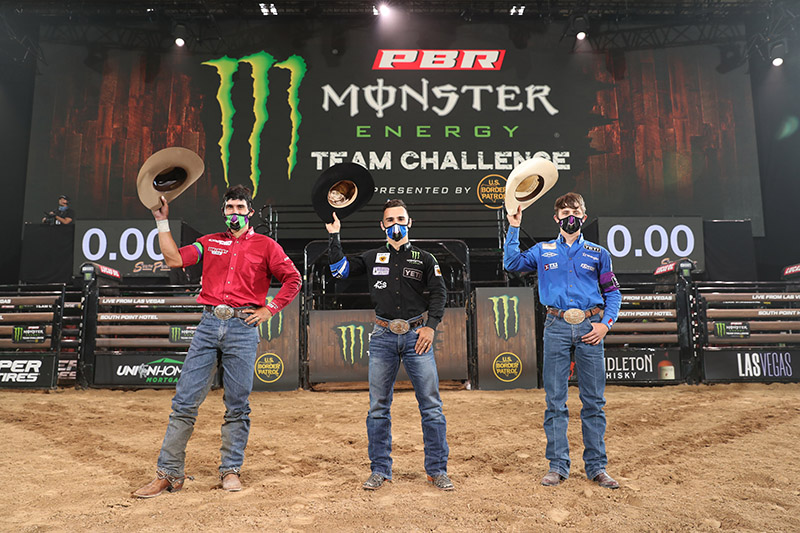
Silvano Alves, Jose Vitor Leme, Stetson Wright, during the first day of the division A Monster Energy Team Challenge PBR in Las Vegas. Photo by Andy Watson
“We were able to share our plan with officials in Oklahoma and returned to competition in April with televised events from the Lazy E Arena in Logan County,” Dan continued. “Following three successful weekends at the Lazy E, we created a new team tournament — the PBR Monster Energy Team Challenge, which would feature 12 teams of four bull riders, competing at South Point Arena in Las Vegas throughout June. The new tournament, televised on CBS and CBS Sports Network, would then culminate in championship weekend July 10-12 in Sioux Falls, South Dakota, where PBR would welcome fans back to the arena at Denny Sanford Premier Center with new fan safety protocols put into place.”

Cowboys in the opening during the second day of the division A Monster Energy Team Challenge PBR. Photo by Andy Watson
When asked to elaborate on specific measures, processes and gear that were put in place to safeguard the performers, technicians, press and any other attendees from contracting Covid-19 at the event, Dan said, “Because of the unique possibility of asymptomatic transmission with this virus, we made the decision early on to require Covid testing of anyone who would be coming into our environment. We knew that if someone tested negative for the virus prior to entering, and never left our bubble, that we could be relatively certain that nobody we were interacting with had the virus.” Dan continued saying, “Beyond that, we took further measures to ensure that spread could be avoided or extremely limited in case someone did become sick or start to show symptoms. We worked with a much smaller team in general than a normal event… about 60 percent of our usual crew, and we broke our entire group down into small functional groups, which were assigned based on proximity or necessary interactions and not necessarily job function. We ensured that functional groups did not cross paths with other groups by segregating catering areas, restrooms, ingress/egress points, and assigning specific boundaries to workspaces. We provided masks and required them to be worn at all times when in public areas or around other people, we sanitized equipment and touch-points regularly through the events, and we temperature screened everyone every day.”

Cowboys in the opening during the sixth day of Division B play at the Monster Energy Team Challenge PBR. Photo by Andy Watson
Overcoming Other Challenges
We also spoke with Dan about the design and operational challenges PBR had to overcome in order to maintain the sport’s typical fan experience, while adhering to the new processes and protocols. He explained, “A typical PBR event is a very high-energy, crowd engaged show. Loud music, lights, pyro, flame, and the cheering crowd all feed into the energy that makes our event what it is. In this design, we wanted to create a more intimate setting than a cavernous arena without fans, but also make sure we brought in elements to keep that high-energy feel for both the broadcast and the riders competing. We did not have to worry about sightlines to seats, and so it was an opportunity to try something different that we could not do under normal circumstances.”

Cowboys in the opening during the third day of the division A Monster Energy Team Challenge PBR. Photo by Andy Watson
Dan continued, “The arena lights were turned off and we lit the whole arena with washes and movers, which let us change the entire feel in the venue on a moment’s notice to react to what was happening in the show. We also installed LED light bars around the floor and hung video walls 360 degrees around the arena with drapes behind to close in the space, along with a custom wood-and-steel set piece in the back center where we placed our broadcast set. 30’ Jib boom cameras were brought in, in place of traditional hard cameras, to ensure that the wide sweeping shots of the venue would translate the look and feel of the environment to the home audience. Line array speakers were placed along the sides of the arena firing in towards the dirt to ensure that the contestants could still feel the energy of the music, even though there were not any fans present to enjoy it.”
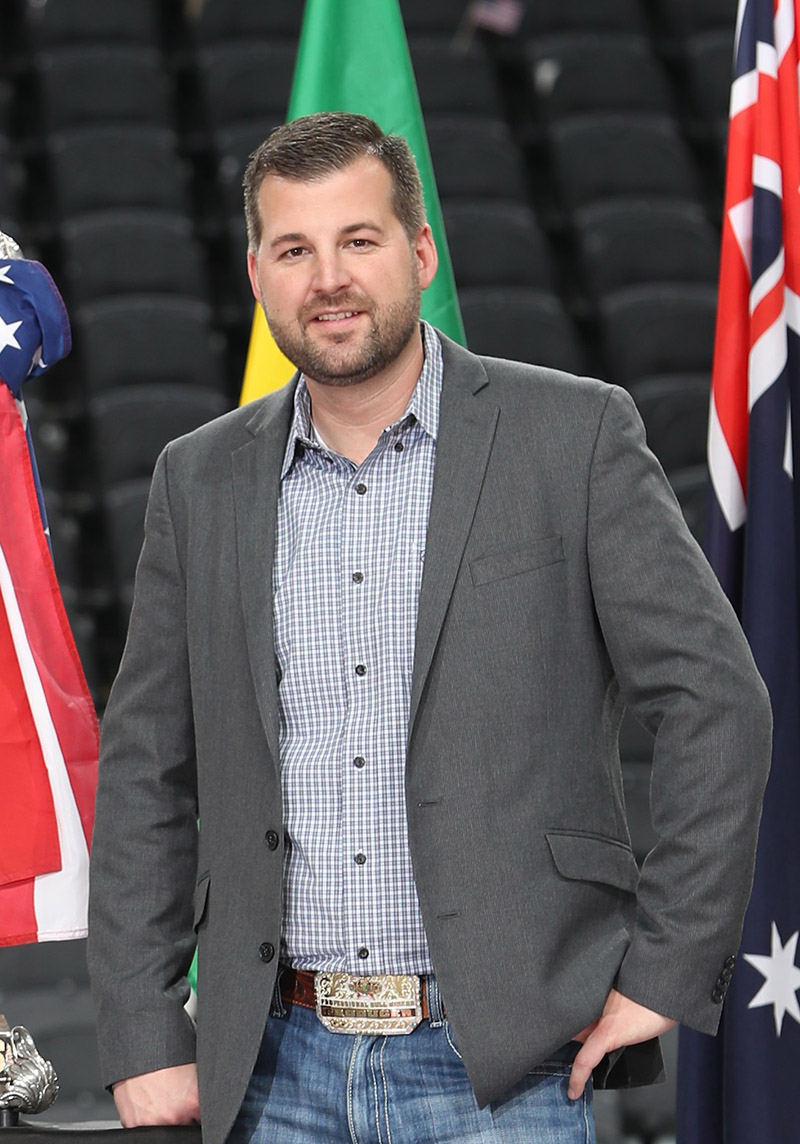
Dan Hickman during the fifth round of the Las Vegas PBR 25th Anniversary Unleash the Beast World Finals. Photo by Andy Watson
Q&A with Dan Hickman
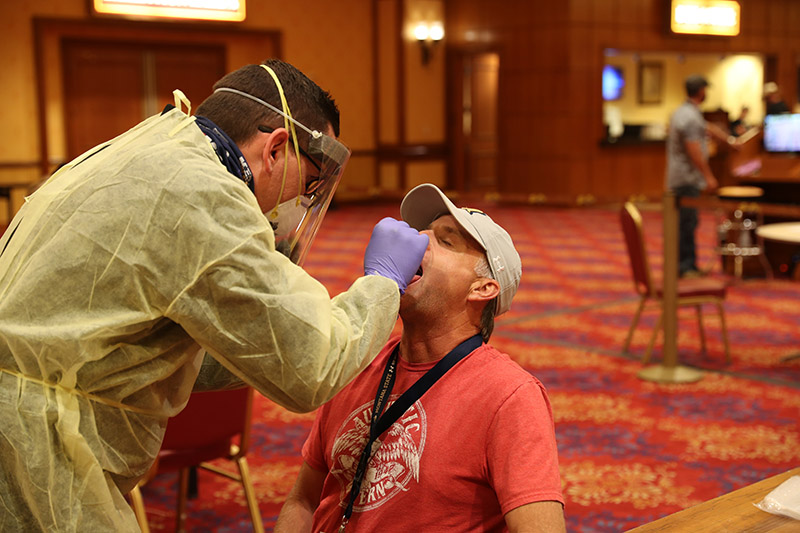
COVID 19 Testing during the Monster Energy Team Challenge PBR. Photo by Andy Watson
PLSN: Which aspects of the measures taken to protect everyone from Covid worked best in your opinion?
Dan Hickman: Daily temperature screenings, rigorous sanitization of equipment and touch-points, and strict adherence to mask usage and social distancing were paramount in being able to pull this off safely and successfully. The most critical aspect in my opinion, though, was the decision to require Covid testing to even set foot inside of the venue. By testing each person immediately upon their arrival, and requiring them to quarantine in their own hotel room until a negative result was received, we could be sure that we were not bringing the virus into our event environment or spreading it unknowingly into the community. Since PBR returned to competition in Oklahoma in late April, in the ensuing seven weekends (three at the Lazy E Arena in Logan County, OK. and four at South Point Arena in Las Vegas), we have only had three athletes test positive for Covid-19, in the sixth week of competition. These asymptomatic athletes, who had been tested upon their initial arrival at South Point, were immediately put into quarantine away from the rest of our group and safely traveled back home in their own private vehicles. Additionally, four other riders who potentially had minimal contact also immediately entered the quarantine processes and did not compete. In the following weeks no athletes or crew have tested positive, so we know that our protocols worked to stop the spread.

COVID 19 Testing during the Monster Energy Team Challenge PBR. Photo by Andy Watson
Were you able to learn anything from doing this first live event that you are now implementing into future shows once a live audience is allowed?
We learned a ton and are still learning more every day as we go on… we’ve gotten into a groove with our medical and safety protocols, and our unique setup in Las Vegas has led to some production elements that we never would have otherwise thought to try, and that we’re looking at how to carry forward into our regular tour. We’ve added automatic temperature screening camera systems at our backstage entrance points to further reduce close interactions and ensure compliance. Now that Covid testing is more readily available nationwide, we’re exploring the idea of letting participants test in their home cities before travelling in and reducing their required time onsite and in quarantine by about 24 hours while still maintaining safety. Rapid testing will be another game changer for us once it’s available and proven. Some of the production elements we’re looking at to potentially bring into the regular fold include additional staging, cameras, lighting elements, and more prominent video walls.

Cowboys in the opening during the third day of Division B play at the Monster Energy Team Challenge PBR. Photo by Andy Watson
When do you forecast PBR being able to do an indoor show with a sold-out audience as it was prior to the Covid-19 pandemic?
PBR is back doing live events in front of audiences as of July 10 in Sioux Falls, South Dakota, and we plan to continue to do so during the second half of 2020. We are operating with reduced capacities and selling seats in socially distanced pods by family or group, and I think that’s probably the way it’s going to be for a while. A ‘sell-out’ might be 50% of true capacity for the time being. We are keeping our finger on the pulse of updated medical guidance and local regulations in every market we look to go to, and the safety of our fans and participants remains the absolute top priority. This virus has proven to have no timetable, so we’ll just have to see how it goes and continue to plan our events carefully and responsibly.
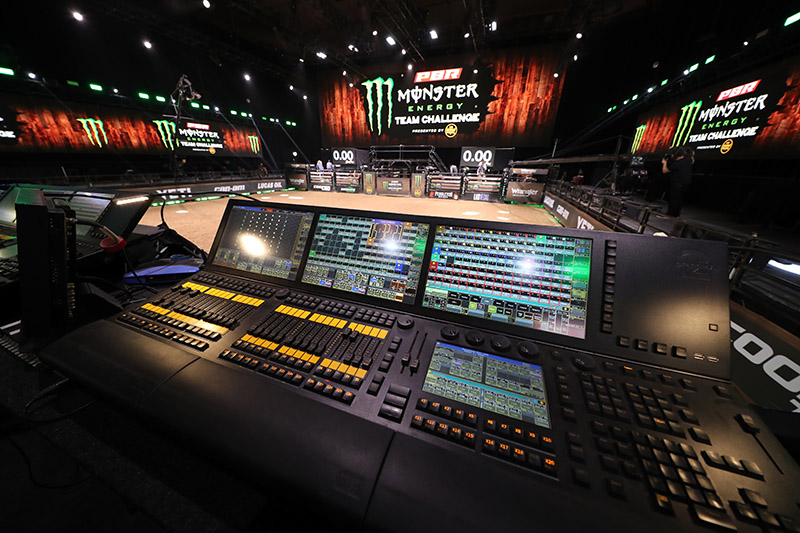
Arena Setup, Tech Layout, during the fourth day of Division B play at the Monster Energy Team Challenge PBR. Photo by Andy Watson
What additional measures will need to be put in place in order to have a full audience, and do you think these new measures will be a permanent part of all show prep in the future?
A key part of our plan is to separate and distance people as much as possible, including the introduction of Pod Seating for all fans to ensure distancing in the stands. We only sold up to 50% of the arena capacity at Denny Sanford Premier Center, as well as at future events in the second half of 2020. In Sioux Falls, we will also emphasize cashless transactions and mobile ticketing for fewer interactions at the box office window. We will eliminate some sponsor activations and other activities on the concourse to create more space among fans. While each market may be a bit different, we are strongly recommending measures like these to our arena partners who share our goal of having a safe event. We will continue to follow government guidance and work with our arena partners to hold safe and responsible events.
PBR Monster Energy Team Challenge
South Point Arena, Las Vegas (June 5-28)
Crew
- VP Production & Operations/Producer: Dan Hickman
- Production Manager/FOH Mixer: Stephen Jester
- Production Manager: James White
- Tour Operations Manager: Audrey Stephenson
- Lighting Design: Jason Robinson
- Lighting Director: Jared Trinnaman
- Lighting/Rigging Vendor: Upstaging/John Huddleston (Account Rep)
- Lighting & Rigging Crew Chief: Mike Hosp
- Lighting Techs: Robin Sheridan, George Reeves, Matt Schiller
- Video Co: Screenworks/Andy Gerber (Account Rep)
- LED Video Crew Chief: Ty Lawson
- LED Video Director: AJ DiCarlo
- LED Techs: Spencer King, Karl Naval, Jason Lowe
- Staging Co: SourceOne Events/Todd McElyea (Account Rep)
- Music Director: Richard Jones
- Audio: PBR (Owned)
- Production Techs: Jack Gardner, Kevin Gideon, Keith Stephens, Charles Isaacs, Sawyer Gibson
Gear
Lighting:
- 3 grandMA2 Full consoles w/3 NPU’s
- 30 Chroma-Q Color Force II fixtures
- 50 SGM Q7’s
- 49 ACME Sunrise XA-1200 BW units
- 24 Claypaky Sharpys
- 1 Custom “Be Cowboy” Set Piece
LED Video Setup:
- Product: X7W V4 -Roe 7mil LED panels
- NovaStar 4K LED processors
- Green Hippo Taiga media server (2)
- Barco ImagePro 4K’s
Screens:
- 2 Clock Screens (4’x8’, HxW; Pixels: 160 x 320)
- 2 Long Side Banners (8’x75’, HxW; Pixels: 320 x 3040)
- 2 Short Side Banners (8’x28’, HxW; Pixels: 320×1120)
- 1 US Wall (21’x 71’, HxW; Pixels: 880×2880)
- 1 Broadcast Booth Floor (Yes Tech 5mm, 672H x 840W)
Cameras:
- 2 Sony HDC3500 w/ 100x Lens
- 1 Sony HDC4300 Super Slo-Mo w/Canon 100x Lens
- 4 Sony HDC3500 w/ Canon Wide-Angle Lens
- 2 Sony HDC 3500 w/ Canon 22x Lens
- 2 30’ Jib Boom
- 3 Marshall POV Camera

Division B Cowboys during the fifth day of Division B play at the Monster Energy Team Challenge PBR. Photo by Andy Watson
About PBR:
PBR (Professional Bull Riders) is the world’s premier bull riding organization. More than 700 bull riders compete in more than 200 events annually across the televised PBR Unleash the Beast Tour (UTB), which features the top 35 bull riders in the world; the PBR Pendleton Whisky Velocity Tour (PWVT); the PBR Touring Pro Division (TPD); and the PBR’s international circuits in Australia, Brazil, Canada and Mexico. PBR is a subsidiary of IMG, a global leader in sports, fashion, events and media. For more information, visit www.PBR.com.
Credit: PLSN, Mike Gormley, September 11, 2020.
Photo Credit: Andy Watson.
